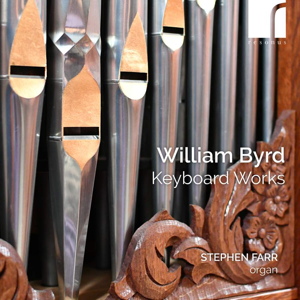
William Byrd (1540-1623)
Keyboard Works
Stephen Farr (organ)
rec. 2023, Sidney Sussex College Chapel, Cambridge, UK
Resonus RES10326 [66]
This year marks the 400th anniversary of the death of William Byrd. In addition to the release of recordings there have been an abundance of events to celebrate this significant landmark. Why is it so important? Byrd is regarded by many as England’s greatest composer of music for the keyboard. One marvels at the sheer scope, diversity, versatility and imagination on display in his music, forged with the stamp of quality. From 1563-1572 he was organist at Lincoln Cathedral and from 1572 held a similar position at the Chapel Royal. Yet, despite being employed by the sovereign he remained a dedicated Roman Catholic throughout his life. He was persecuted as a recusant, yet his art stayed tethered to the old faith.
Byrd’s keyboard works have always had a lesser profile than his choral music. Yet, these works offer the listener a wealth of riches. The jury’s out as to which instrument Byrd had in mind when he composed his keyboard music – was it the clavichord, virginal, harpsichord or organ? I personally haven’t heard any of his keyboard works performed on the organ before. Needless to say, I find they work very well. Farr’s approach is one of meticulous research and informed musicianship, and his choice of programme reveals the great variety of moods and wealth of imagination this music has to offer.
The Voluntary in C major which opens the disc is on a grand scale and at just over nine minutes is one of the most substantial works on the disc. Its stately and dignified bearing makes it a fitting curtain-raiser. The other more expansive works in the collection are the Fantasias, described in the notes as “a writer building structures patiently”. In these, and we get four of them, we hear the composer’s imagination given full rein. Farr employs some exquisite bird-like registrations in the two Misereres, and decorates them with an array of florid, filigree ornamentation. Ut re mi fa sol la in G is a hexachord fantasia focusing on the first six notes of the major scale. The piece alludes to the hymn Ut queant laxis resonare fibris. Farr conveys the profound depths of this intriguing work with skill and penetrating vision. There’s an eloquent dialogue underpinning O quam gloriosum est regnum tuum, which is here both fluent and persuasive and delivered with exceptional clarity.
Stephen Farr performs on the Taylor and Boody Organ of Sidney College, Cambridge, a historically informed instrument built in the early English style, well suited to the intimacy and scale of this music. Great skill has gone into the recording to ensure that its presence is felt at all dynamic levels. Francis O’Gorman provides the liner notes, which offer a splendid overview of the composer, setting him in a historical context, together with discussion of the music played. Organ specifications are included. This very fine release is a worthy 400th anniversary tribute
Stephen Greenbank
Help us financially by purchasing from


Contents
Voluntary in C Major
Fantasia in A minor
Miserere (I)
Miserere (II)
Fantasia in C major
Verse
Fantasia in G major [11]
Gloria tibi Trinitas
Fantasia in G Major [I]
Ut, re, mi, fa, sol, la in G major
Voluntary in A Minor / C Major
O quam gloriosum est regnum
I. Prima pars
II. Secunda pars


















